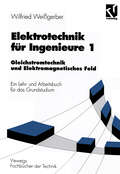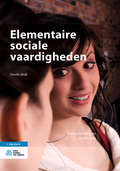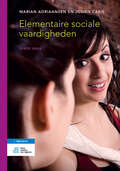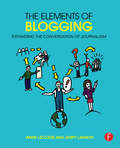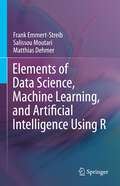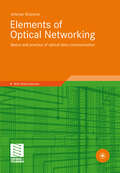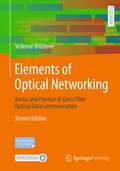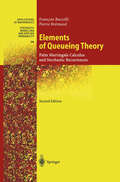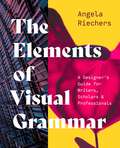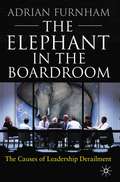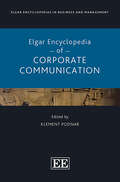- Table View
- List View
Elektronische Textkommunikation in Deutschland und Japan / Electronic Text Communication in Germany and Japan: Konzepte, Anwendungen, Soziale Wirkungen, Einführungsstrategien / Concepts, Applications, Social Impacts, Implementation Strategies (Telecommunications #10)
by E. Witte W. LämmleElektrotechnik für Ingenieure 1: Gleichstromtechnik und Elektromagnetisches Feld. Ein Lehr- und Arbeitsbuch für das Grundstudium (Viewegs Fachbücher der Technik)
by Wilfried WeißgerberDieses auf drei Bände angelegte Lehr- und Arbeitsbuch führt in ausführlicher und systematischer Weise in die Grundlagen und Berechnungsverfahren der Elektrotechnik ein. Alle Berechnungsverfahren werden sorgfältig hergeleitet, jeder Rechenschritt kann sofort nachvollzogen werden. Zahlreiche Aufgaben, deren Lösungsweg im Anhang eingehend beschrieben wird, unterstützen nach jedem Kapitel den Lernerfolg.
Elektrotechnik für Ingenieure 1: Gleichstromtechnik und Elektromagnetisches Feld. Ein Lehr- und Arbeitsbuch für das Grundstudium
by Wilfried WeißgerberDieses mehrbändige Lehr- und Arbeitsbuch führt in ausführlicher und systematischer Weise in die Grundlagen und Berechnungsverfahren der Elektrotechnik ein. Zahlreiche Aufgaben, deren Lösungsweg im Anhang eingehend beschrieben wird, unterstützen nach jedem Kapitel den Lernerfolg. In diesem ersten Band werden die physikalischen Grundgrößen der Elektrotechnik eingeführt, dann die Gleichstromtechnik behandelt und schließlich das elektromagnetische Feld ausführlich behandelt. Ein Verzeichnis der verwendeten Schreibweisen, Formelzeichen und Einheiten erleichtert das Arbeiten mit dem Buch.
Elektrotechnik für Ingenieure 1: Gleichstromtechnik und Elektromagnetisches Feld. Ein Lehr- und Arbeitsbuch für das Grundstudium (Viewegs Fachbücher der Technik)
by Wilfried WeißgerberDieses mehrbändige Lehr- und Arbeitsbuch führt in ausführlicher und systematischer Weise in die Grundlagen und Berechnungsverfahren der Elektrotechnik ein. Zahlreiche Aufgaben, deren Lösungsweg im Anhang eingehend beschrieben wird, unterstützen nach jedem Kapitel den Lernerfolg. In diesem ersten Band werden die physikalischen Grundgrößen der Elektrotechnik eingeführt, dann die Gleichstromtechnik behandelt und schließlich das elektromagnetische Feld ausführlich behandelt.
Elektrotechnik und Elektronik in Maschinenbau und Mechatronik: Für Studierende und für die Praxis
by Julian EndresAnlagen und Maschinen werden immer komplexer, auch weil in ihnen immer mehr Elektronik verbaut ist. Die Grundlagen und die Anwendungen der Elektrotechnik, der Elektronik und der Kommunikationstechnik spielen daher für den Maschinenbau eine immer wichtigere Rolle. Dieser Entwicklung trägt das Buch Rechnung. Es stellt die Grundlagen dieser Fachgebiete sowie der Halbleiter- und Leistungselektronik ausführlich dar. Zudem behandelt es elektrische Maschinen und Anlagen, Energieversorgung und die Datenkommunikation mit Feldbussen. Jeder Abschnitt ist in gleicher Weise gegliedert: Eine strukturierte Übersicht zeigt die Zusammenhänge auf, Beispiele verdeutlichen die Rechnungen und die Gedankengänge, Diagramme und Fotos veranschaulichen die Anwendungen. Zusammen mit den Übungsaufgaben und Lösungen ergibt sich ein didaktischer Aufbau, der es Lesern erleichtert, sich in die Elektrotechnik und die Elektronik einzuarbeiten.Für die 4. Auflage wurden die Inhalte aktualisiert und ergänzt. Unter anderem wurde eine Einführung in elektrische Fahrzeugantriebe eingefügt und das Kapitel zur Energieversorgung um Abschnitte zur Energieübertragung in Stromnetzen erweitert. Das Werk eignet sich als Lehrbuch für Studierende der Ingenieurwissenschaften, insbesondere des Maschinenbaus, richtet sich aber auch an angehende Wirtschaftsingenieure und Mechatroniker. Für Ingenieure im Beruf ist der Band ein umfassendes und fundiertes Nachschlagewerk – auch wenn es um neue Herausforderungen in den Bereichen Industrie 4.0 und elektrische Antriebstechnogien geht.
Elementaire sociale vaardigheden: Transferpunt Vaardigheidsonderwijs
by Marian Adriaansen Josien CarisDit boek helpt studenten in zorg en welzijn om communicatieve basisvaardigheden zó aan te leren dat die een solide basis vormen voor de ontwikkeling van specifieke beroepsvaardigheden. Ook leren ze om die communicatieve vaardigheden in verschillende hulpverleningssituaties toe te passen. Daarbij heeft het boek aandacht voor aan te leren technieken, én voor de echtheid van iemands optreden. Effectief communiceren vereist immers ook kennis over je eigen kwaliteiten. Elementaire sociale vaardigheden gaat uitgebreid in op de theorie, én is erg praktijkgericht. Het s een verdiepend boek, dat studenten handvatten geeft om theorie te oefenen en toe te passen. Aan deze geheel herziene druk is bovendien een nieuw hoofdstuk toegevoegd: omgaan met laaggeletterdheid. Ook nieuw is de mogelijkheid om met behulp van een app direct vanuit het boek de bijpassende filmfragmenten te bekijken. In deze filmfragmenten worden de besproken vaardigheden gedemonstreerd. Ze staan ook op mijn.bsl.nl - net als de toetsvragen, studieopdrachten en oefeningen. Zo kun je eenvoudig kennismaken met de beoogde vaardigheden, en ze actief oefenen.
Elementaire sociale vaardigheden
by Marian Adriaansen Josien CarisCommuniceren is een belangrijk onderdeel van vrijwel elk beroep. Of communicatieprocessen effectief verlopen is niet alleen afhankelijk van aan te leren technieken, maar vooral ook van de 'echtheid' van iemands optreden. Om effectief te kunnen communiceren heb je (zelf)kennis nodig over je eigen kwaliteiten.Dit leermateriaal helpt je om de basisvaardigheden zo aan te leren dat zij kunnen dienen als solide basis voor de ontwikkeling van je specifieke beroepsvaardigheden. De auteurs besteden in de hoofdstukken op oriënterend niveau ook aandacht aan de toepassing van de basisvaardigheden in verschillende hulpverleningssituaties binnen welzijn en gezondheidszorg.Nieuw is de website met daarop een serie filmfragmenten waarin de besproken vaardigheden worden gedemonstreerd. Op deze website zijn ook toetsvragen, studieopdrachten en oefeningen opgenomen, die een actieve wijze van kennismaken met en oefenen van de beoogde vaardigheden mogelijk maken.Aan deze geheel herziene druk zijn twee nieuwe hoofdstukken toegevoegd: Argumenteren en Digitaal communiceren.Waar vele boeken vooral ingaan op de theorie, is dit boek ook erg praktijkgericht. Het geeft studenten goede handvatten om theorie toe te passen en te oefenen, waardoor het boek meer is dan alleen een verdiepend boek.
Elemente internationaler Medienwissenschaften: Eine Einführung in innovative Konzepte
by Peter LudesDie weltweite Finanzkrise seit 2008 und die Nuklearkatastrophe in Fukushima seit März 2011 erreichten die meisten Menschen zunächst als Medienbilder, die – im Unterschied zu Tschernobyl 1986 – in Echtzeit weltweit kommuniziert wurden. Aber Infrastrukturen der Verschleierung erlaubten kaum Recherchen hinter den Kulissen. Auch die weiterhin oft national orientierten Medien- und Kommunikationswissenschaften berücksichtigen zu selten internationale Vernetzungen. Die neuen Herausforderungen des 21. Jahrhunderts für die Perspektive einer internationalen Medienwissenschaft erfordern aber neue Problemsichten. Diese werden in den folgenden Kapiteln vorgestellt als vernetzte Kommunikationssplitter, Schlüsselbild-Gewohnheiten, Informationsüberfluss und Wissensknappheit, mit besonderen Hinweisen auf China und die USA, Brasilianisierung Europas und indische Vielfalt unter Aspekten der Zivilisationstheorie, multiple Symbolisierungen, vernetzte Medienöffentlichkeiten, Informationsumbrüche und Infrastrukturen der Verschleierung, europäische Perspektiven und vollsinnliche Erlebnisse.
Elemente optischer Netze: Grundlagen und Praxis der optischen Datenübertragung
by Volkmar BrücknerIn diesem einführenden und kompakten Lehrbuch werden die wichtigsten Elemente von optischen Netzen eingeführt und für die ingenieurmäßige Lösung praktischer Probleme aufbereitet. Thematische Schwerpunkte sind Glas- und Polymerfasern, optische Sender und Empfänger, die Modulation von Laserlicht für hochbitratige Übertragungen, Elemente passiver (Koppler, Verzweiger) und aktiver (Schalter, optische Verstärker) Netze und der Einfluss nichtlinearer Effekte auf die optische Datenübertragung. An Beispielen werden Vorteile und Grenzen der Datenübertragung in optischen Netzen erläutert. Zu jedem Schwerpunkt werden praxisnahe bzw. praxisorientierte Fragen und Aufgaben gestellt. Schwierige mathematische Zusammenhänge und Formeln werden nachvollziehbar in MathCad® simuliert.
Elemente optischer Netze: Grundlagen und Praxis der optischen Datenübertragung
by Volkmar BrücknerIn diesem einführenden und kompakten Lehrbuch werden die wichtigsten Elemente von optischen Netzen eingeführt und für die ingenieurmäßige Lösung praktischer Probleme aufbereitet. Thematische Schwerpunkte sind Glas- und Polymerfasern, optische Sender und Empfänger, die Modulation von Laserlicht für hochbitratige Übertragungen, Elemente passiver (Koppler, Verzweiger) und aktiver (Schalter, optische Verstärker) Netze und der Einfluss nichtlinearer Effekte auf die optische Datenübertragung. An Beispielen werden Vorteile und Grenzen der Datenübertragung in optischen Netzen erläutert. Zu jedem Schwerpunkt werden praxisnahe bzw. praxisorientierte Fragen und Aufgaben gestellt. Schwierige mathematische Zusammenhänge und Formeln werden nachvollziehbar in MathCad® simuliert.
The Elements of Blogging: Expanding the Conversation of Journalism
by Mark Leccese Jerry LansonBecoming a blogger takes practice, hard work, and, ultimately, a passion for the craft. Whether you plan to blog on politics or parenting, The Elements of Blogging is designed to give you the skills and strategies to get started, to sustain your work, and to seek out a robust audience. This book is loaded with practical advice on important topics such as determining a niche, finding the best stories, and blogging effectively and ethically. It features examples from both amateur and professional bloggers that show the techniques for building an argument, finding a voice, crafting a headline, and establishing a brand. Key features: Real-world applicability. This book includes thumbnail profiles of bloggers and their sites, which illuminate key skills you will need to become an effective blogger Interactivity. Each chapter features discussion points and exercises intended to get you to think about, reflect on, and apply the contents of each chapter Creativity. While this book dives into software and plug-ins for bloggers, its main goal is to cover how to write blogs on a myriad of topics: news, opinion pieces, travel, politics, art, and more. Visit the companion website: http://www.theelementsofblogging.com/
The Elements of Blogging: Expanding the Conversation of Journalism
by Mark Leccese Jerry LansonBecoming a blogger takes practice, hard work, and, ultimately, a passion for the craft. Whether you plan to blog on politics or parenting, The Elements of Blogging is designed to give you the skills and strategies to get started, to sustain your work, and to seek out a robust audience. This book is loaded with practical advice on important topics such as determining a niche, finding the best stories, and blogging effectively and ethically. It features examples from both amateur and professional bloggers that show the techniques for building an argument, finding a voice, crafting a headline, and establishing a brand. Key features: Real-world applicability. This book includes thumbnail profiles of bloggers and their sites, which illuminate key skills you will need to become an effective blogger Interactivity. Each chapter features discussion points and exercises intended to get you to think about, reflect on, and apply the contents of each chapter Creativity. While this book dives into software and plug-ins for bloggers, its main goal is to cover how to write blogs on a myriad of topics: news, opinion pieces, travel, politics, art, and more. Visit the companion website: http://www.theelementsofblogging.com/
Elements of Data Science, Machine Learning, and Artificial Intelligence Using R
by Frank Emmert-Streib Salissou Moutari Matthias DehmerThe textbook provides students with tools they need to analyze complex data using methods from data science, machine learning and artificial intelligence. The authors include both the presentation of methods along with applications using the programming language R, which is the gold standard for analyzing data. The authors cover all three main components of data science: computer science; mathematics and statistics; and domain knowledge. The book presents methods and implementations in R side-by-side, allowing the immediate practical application of the learning concepts. Furthermore, this teaches computational thinking in a natural way. The book includes exercises, case studies, Q&A and examples.
Elements of Detection and Signal Design (Springer Texts in Electrical Engineering)
by Charles L. WeberDue to a steady flow of requests over several years, Springer-Verlag now provides a corrected reprint of this text. It is designed to serve as a text for a first semester graduate level course for students in digital communication systems. As a pre requisite, it is presumed that the reader has an understanding of basic probability and stochastic processes. The treatment of digital communications in this book is intended to serve as an introduction to the subject. Part one is a development of the elements of statistical communication theory and radar detection. The text begins with a general model of a communication system which is extensively developed and the performance analyses of various conventional systems. The first part also serves as introductory material for the second part of the text which is a comprehensive study of the theory of transmitter optimization for coherent and noncoherent digital commu nication systems, that is, the theory of signal design.
The Elements of International English Style: A Guide to Writing Correspondence, Reports, Technical Documents, and Internet Pages for a Global Audience
by Edmond H. WeissThis easy-to-use handbook is an essential resource for anyone who needs to write English correspondence for an international business audience. In an engaging, accessible style it integrates the theory and controversies of intercultural communication with the practical skills of writing and editing English for those who read it as a second language. The book emphasizes principles of simplicity and clarity, proper etiquette, cultural sensitivity, appropriate layout and typography, and more to increase the chances that a text prepared by a native English speaker will be better understood by a non-native speaker. It also updates traditional advice with new insights into "e-mail culture." Equally useful for students and professionals in business communication, marketing communication, and international business, The Elements of International English Style is filled with realistic examples, problems, and projects, including: 57 specific tactics to internationalize one's English; hundreds of before-and-after comparisons showing the effects of editing for an international audience; models of international correspondence; practical discussion questions and work projects; useful resources for further study, including books, articles, and websites.
The Elements of International English Style: A Guide to Writing Correspondence, Reports, Technical Documents, and Internet Pages for a Global Audience
by Edmond H. WeissThis easy-to-use handbook is an essential resource for anyone who needs to write English correspondence for an international business audience. In an engaging, accessible style it integrates the theory and controversies of intercultural communication with the practical skills of writing and editing English for those who read it as a second language. The book emphasizes principles of simplicity and clarity, proper etiquette, cultural sensitivity, appropriate layout and typography, and more to increase the chances that a text prepared by a native English speaker will be better understood by a non-native speaker. It also updates traditional advice with new insights into "e-mail culture." Equally useful for students and professionals in business communication, marketing communication, and international business, The Elements of International English Style is filled with realistic examples, problems, and projects, including: 57 specific tactics to internationalize one's English; hundreds of before-and-after comparisons showing the effects of editing for an international audience; models of international correspondence; practical discussion questions and work projects; useful resources for further study, including books, articles, and websites.
The Elements of Negotiation: 103 Tactics for Everyone to Win in Each Deal
by Keld JensenComprehensive guide to mastering negotiation, based on 24 years of research The Elements of Negotiation provides readers with an easy-to-follow step-by-step approach to becoming exceptional negotiators in both their professional and personal lives. Grounded in 24 years of extensive research, studying the habits and techniques of 35,000 individual negotiators, the 103 steps provide a detailed roadmap for negotiation excellence, covering preparation, execution, and post-negotiation analysis. Backed by tested science proving the tips' efficacy, The Elements of Negotiation explores a wealth of real-world case studies and examples, with trends and predictions into the future of negotiation, and additional resources and training programs to further improve your negotiation skills. In this book, you'll learn: How to prepare for negotiations to achieve superior financial outcomes What to say—and not say—during any negotiation, big or small How successful negotiators achieve positive outcomes for both parties Why successful negotiators are usually successful in both their personal and professional lives With its research-backed approach and the expertise of Keld Jensen, an international authority on negotiation with countless accolades and clients like the Financial Times, Target, Government of Canada, and UCLA, The Elements of Negotiation is an invaluable resource for anyone looking to elevate their negotiation skills.
The Elements of Negotiation: 103 Tactics for Everyone to Win in Each Deal
by Keld JensenComprehensive guide to mastering negotiation, based on 24 years of research The Elements of Negotiation provides readers with an easy-to-follow step-by-step approach to becoming exceptional negotiators in both their professional and personal lives. Grounded in 24 years of extensive research, studying the habits and techniques of 35,000 individual negotiators, the 103 steps provide a detailed roadmap for negotiation excellence, covering preparation, execution, and post-negotiation analysis. Backed by tested science proving the tips' efficacy, The Elements of Negotiation explores a wealth of real-world case studies and examples, with trends and predictions into the future of negotiation, and additional resources and training programs to further improve your negotiation skills. In this book, you'll learn: How to prepare for negotiations to achieve superior financial outcomes What to say—and not say—during any negotiation, big or small How successful negotiators achieve positive outcomes for both parties Why successful negotiators are usually successful in both their personal and professional lives With its research-backed approach and the expertise of Keld Jensen, an international authority on negotiation with countless accolades and clients like the Financial Times, Target, Government of Canada, and UCLA, The Elements of Negotiation is an invaluable resource for anyone looking to elevate their negotiation skills.
Elements of Optical Networking: Basics and practice of optical data communication
by Volkmar BrücknerElements of Optical Networking: Basics and Practice of Glass Fiber Optical Data Communication
by Volkmar BrücknerThis compact textbook introduces the most important elements of optical networks and uses them to solve practical problems by engineering solutions. The main topics are glass fibers, optical transmitters and receivers, modulation of laser light for high bit rates, elements of passive (couplers, distributors) and active (switches, optical amplifiers) networks, influence of nonlinearities in optical transmission as well as integration into the global network. Examples describe advantages and limits of optical data transfer in networks. In addition to each topic, practical exercises and questions are given. Difficult mathematical relationships and formulas are explained and simulated using a mathematical program.This textbook has been recommended and developed for university courses in Germany, Austria and Switzerland.The contentPhotonics, wave-guide structures, glass fibers – Parameters and properties of optical fibers: attenuation and dispersion, transmission bandwidth – Optical transmitters, modulation of transmitters – Optical amplifiers – Optical receivers – Active and passive optical couplers and switches – Nonlinear processes in glass fibers, solitons – Active and passive optical networksTarget GroupsStudents of Bachelor and Master courses at Universities of Applied SciencesStudents of Bachelor courses at Technical UniversitiesPractitioners in the fields of telecommunications and communication technologyLife-long learners
Elements of Queueing Theory: Palm Martingale Calculus and Stochastic Recurrences (Stochastic Modelling and Applied Probability #26)
by Francois Baccelli Pierre BremaudThis fundamental exposition of queueing theory, written by leading researchers, answers the need for a mathematically sound reference work on the subject and has become the standard reference. The thoroughly revised second edition contains a substantial number of exercises and their solutions, which makes the book suitable as a textbook.
The Elements of Visual Grammar: A Designer's Guide for Writers, Scholars, and Professionals (Skills For Scholars Ser.)
by Angela RiechersA color-illustrated introduction to the basic principles of visual language that every content creator and consumer needs to knowThe right images capture attention, pique curiosity, and inspire viewers to stick around long enough to read any accompanying text. Nearly everyone today needs to use or understand images in communications of all kinds, from the most formal professional publication to the most casual social media post, and knowing the basics of visual language is essential for content creators and consumers alike. However, most people aren’t taught visual grammar unless they go into art- or design-related fields. The Elements of Visual Grammar explains image use in any media in practical terms for writers, scholars, and other professionals. Award-winning art director and design professor Angela Riechers offers a flexible set of principles and best practices for selecting images that work—and using them in the most persuasive way. The result is an indispensable guide for anyone who wants to learn how to work more successfully with images and words.Features more than 200 color illustrations—drawn from a wide range of styles, media, and eras—that demonstrate the principles of visual grammar and how images can support and enhance written contentDefines and illustrates the basic elements of images, describes how images function within text regardless of media, and explains how to choose images and integrate them with textIntroduces the practical, cultural, conceptual, and scientific factors that influence image useAnalyzes images by function and describes ways to employ symbolism, synecdoche, allegory, metaphor, analogy, and iconography
The Elements of Visual Grammar: A Designer's Guide for Writers, Scholars, and Professionals (Skills For Scholars Ser.)
by Angela RiechersA color-illustrated introduction to the basic principles of visual language that every content creator and consumer needs to knowThe right images capture attention, pique curiosity, and inspire viewers to stick around long enough to read any accompanying text. Nearly everyone today needs to use or understand images in communications of all kinds, from the most formal professional publication to the most casual social media post, and knowing the basics of visual language is essential for content creators and consumers alike. However, most people aren’t taught visual grammar unless they go into art- or design-related fields. The Elements of Visual Grammar explains image use in any media in practical terms for writers, scholars, and other professionals. Award-winning art director and design professor Angela Riechers offers a flexible set of principles and best practices for selecting images that work—and using them in the most persuasive way. The result is an indispensable guide for anyone who wants to learn how to work more successfully with images and words.Features more than 200 color illustrations—drawn from a wide range of styles, media, and eras—that demonstrate the principles of visual grammar and how images can support and enhance written contentDefines and illustrates the basic elements of images, describes how images function within text regardless of media, and explains how to choose images and integrate them with textIntroduces the practical, cultural, conceptual, and scientific factors that influence image useAnalyzes images by function and describes ways to employ symbolism, synecdoche, allegory, metaphor, analogy, and iconography
The Elephant in the Boardroom: The causes of leadership derailment
by A. FurnhamThis book from the acclaimed management writer Adrian Furnham, explores the dark side of leadership and how and why leaders can have a negative impact upon their companies and organisations. It asks why too often people do not speak out but instead ignore the problems they are causing.
Elgar Encyclopedia of Corporate Communication (Elgar Encyclopedias in Business and Management series)
This comprehensive Encyclopedia captures the intricacies of corporate communication, offering 87 clear, succinct definitions of important concepts within marketing, business, organizational communication and public relations followed by critical, literary analyses of significant research ventures. Emphasizing the interdisciplinary nature of corporate communication, this timely Encyclopedia links topics including selected theories, organization as an entity, corporate branding, corporate responsibilities, corporate misbehaviour, communication processes and tools, stakeholder engagement, corporate communication outcomes and negative corporate association in a clear and accessible format. Eleven key themes are addressed to fully illustrate the complexity of communication in a modern corporate landscape, ranging from selected theories and theoretical approaches to positive and negative corporate associations, providing both practical and conceptual insight. Further recommended readings which demonstrate the expansive nature of topics within corporate communication are provided.The Elgar Encyclopedia of Corporate Communication will be an essential reference text for students focusing on corporate communication and related management disciplines and fields such as communication, corporate identity and reputation, branding, public relations, marketing and organizational behaviour. Due to its real-world implications, it will additionally be of great benefit for practitioners seeking to understand important trends and developments within corporate communication.

